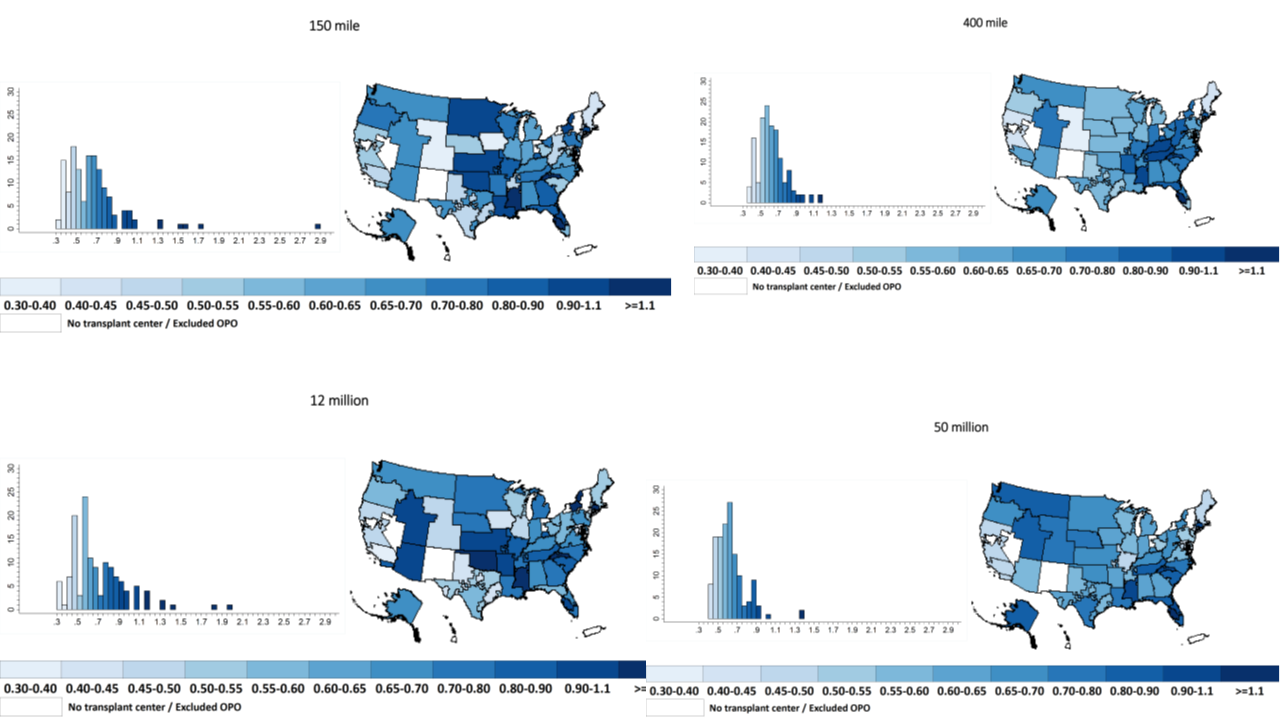Geographic Disparities in Liver Supply/Demand Ratio within Fixed-Distance and Fixed-Person Circles
1JHU, Baltimore, MD, 2USNA, Baltimore, MD
Meeting: 2019 American Transplant Congress
Abstract number: C280
Keywords: Allocation, Liver transplantation
Session Information
Session Name: Poster Session C: Liver: MELD, Allocation and Donor Issues (DCD/ECD)
Session Type: Poster Session
Date: Monday, June 3, 2019
Session Time: 6:00pm-7:00pm
 Presentation Time: 6:00pm-7:00pm
Presentation Time: 6:00pm-7:00pm
Location: Hall C & D
*Purpose: Geographic disparity in deceased donor liver allocation has been extensively documented. Many stakeholders believe allocating within circular fixed-distance or fixed-person boundaries would reduce geographic disparity.
*Methods: We identified 27,334 transplanted deceased donor livers and 44,652 incident waitlist candidates with MELD≥15 using SRTR data (07/2013-06/2017). We examined organ supply/demand ratios for 142 transplant centers. Supply was the number of donors from ZIP codes around a center, allocated proportionally according to waitlist size, and demand was the number of liver registrants. We measured disparity (variance) in supply/demand ratio between transplant centers for DSAs, fixed-distance circles (150- or 400-mile radius), and fixed-person (12- or 50-million) circles with the variance ratio test.
*Results: The variance in supply/demand ratio within DSAs was 0.11, which did not decrease for 150-mile radius circles (variance=0.11, p=0.9) or 12-million-person circles (variance=0.08, p=0.1). However, the variance in supply/demand ratio decreased substantially from 0.11 to 0.02 in larger fixed-distance (400-mile, p<0.001) and larger fixed-person (50-million, p<0.001) circles. Compared to fixed-distance circles, fixed-person circles with similar median radius yield similar reductions in disparity across transplant centers (400-mile vs. 50-million, p=0.9; 150-mile vs. 12-million, p=0.3).
*Conclusions: Small fixed-distance (150-mile) or fixed-person circles (12-million) do not reduce geographic disparity compared to DSAs. Fixed-distance or fixed-person circles must be larger than those in current allocation policy to reduce geographic disparities.
To cite this abstract in AMA style:
Haugen C, Ishaque T, Sapirstein A, Segev D, Gentry S. Geographic Disparities in Liver Supply/Demand Ratio within Fixed-Distance and Fixed-Person Circles [abstract]. Am J Transplant. 2019; 19 (suppl 3). https://atcmeetingabstracts.com/abstract/geographic-disparities-in-liver-supply-demand-ratio-within-fixed-distance-and-fixed-person-circles/. Accessed December 18, 2025.« Back to 2019 American Transplant Congress

